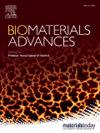3D pancreatic ductal adenocarcinoma desmoplastic model: Glycolysis facilitating stemness via ITGAV-PI3K-AKT-YAP1
IF 5.5
2区 医学
Q2 MATERIALS SCIENCE, BIOMATERIALS
Materials Science & Engineering C-Materials for Biological Applications
Pub Date : 2025-01-29
DOI:10.1016/j.bioadv.2025.214215
引用次数: 0
Abstract
The distinctive desmoplastic tumor microenvironment (TME) of pancreatic ductal adenocarcinoma (PDAC) is crucial in determining the stemness of tumor cells. And the conventional two-dimensional (2D) culture does not adequately mimic the TME. Therefore, a three-dimensional (3D) PDAC desmoplastic model was constructed using GelMA and HAMA, which provides benefits in terms of simulating both the main components (COL and HA) and the crosslinking of the extracellular matrix. We found that the 3D PDAC desmoplastic model upregulated the expression of the markers for stemness (NANOG and OCT4) and glycolysis (HK2 and GLUT2), and elevated the level of glycolysis, including increased glucose consumption and lactic acid production. Additionally, YAP1 played a crucial role in promoting glycolysis, which boosted stemness. Furthermore, RNA sequencing (RNA-seq) was employed to explore the underlying mechanisms associated with stemness within the 3D desmoplastic model. Subsequent KEGG pathway analysis indicated the activation of the PI3K-AKT signaling pathway, providing insights into the molecular processes at play. Using bioinformatics, qRT-PCR and western blot, we proposed that ITGAV-PI3K-AKT-YAP1 axis may account for the glycolysis mediated the stemness. Collectively, the 3D desmoplastic model may serve as a new platform for understanding the underlying mechanism by which the TME induces stemness.

求助全文
约1分钟内获得全文
求助全文
来源期刊
CiteScore
17.80
自引率
0.00%
发文量
501
审稿时长
27 days
期刊介绍:
Biomaterials Advances, previously known as Materials Science and Engineering: C-Materials for Biological Applications (P-ISSN: 0928-4931, E-ISSN: 1873-0191). Includes topics at the interface of the biomedical sciences and materials engineering. These topics include:
• Bioinspired and biomimetic materials for medical applications
• Materials of biological origin for medical applications
• Materials for "active" medical applications
• Self-assembling and self-healing materials for medical applications
• "Smart" (i.e., stimulus-response) materials for medical applications
• Ceramic, metallic, polymeric, and composite materials for medical applications
• Materials for in vivo sensing
• Materials for in vivo imaging
• Materials for delivery of pharmacologic agents and vaccines
• Novel approaches for characterizing and modeling materials for medical applications
Manuscripts on biological topics without a materials science component, or manuscripts on materials science without biological applications, will not be considered for publication in Materials Science and Engineering C. New submissions are first assessed for language, scope and originality (plagiarism check) and can be desk rejected before review if they need English language improvements, are out of scope or present excessive duplication with published sources.
Biomaterials Advances sits within Elsevier''s biomaterials science portfolio alongside Biomaterials, Materials Today Bio and Biomaterials and Biosystems. As part of the broader Materials Today family, Biomaterials Advances offers authors rigorous peer review, rapid decisions, and high visibility. We look forward to receiving your submissions!
文献相关原料
公司名称
产品信息
索莱宝
Lactic Acid Content Assay Kit
索莱宝
hyaluronidase
索莱宝
collagenase I
索莱宝
TRITC phalloidin solution
索莱宝
Calcein-AM/PI Live/Dead Kit

 求助内容:
求助内容: 应助结果提醒方式:
应助结果提醒方式:


